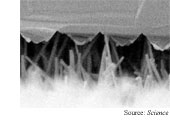|
NEWS
|
Relatively faster
When certain physics simulations are designed
so that their frames of reference are imagined to be moving
near light speed, Einstein's theory of special relativity
reduces the simulations' complexity. The technique could
be used to dramatically reduce the computer power and/or
time needed for simulations of high-power lasers and particle
beams. (Noninvariance
of Space- and Time-Scale Ranges under a Lorentz Transformation
and the Implications for the Study of Relativistic Interactions,
Physical Review Letters, March 30, 2007)
Nano generator
 A nanoscale generator made from an array of zinc
oxide nanowires topped by a jagged metal electrode converts
ultrasonic waves to a continuous flow of electricity.
The generator could be used to harvest energy from vibrations;
this energy could be used to power nanoscale devices.
(Direct-Current
Nanogenerator Driven by Ultrasonic Waves, Science,
April 6, 2007)
A nanoscale generator made from an array of zinc
oxide nanowires topped by a jagged metal electrode converts
ultrasonic waves to a continuous flow of electricity.
The generator could be used to harvest energy from vibrations;
this energy could be used to power nanoscale devices.
(Direct-Current
Nanogenerator Driven by Ultrasonic Waves, Science,
April 6, 2007)
Solar coax
Coaxial nanowires made from different semiconductors
efficiently separate negatively-charged electrons from
positively-charged holes when photons from the sun dislodge
electrons from the nanowires. These quantum coaxial cables
could be used to boost the efficiency of solar cells and
devices that extract hydrogen from water using sunlight.
("Quantum
Coaxial Cables" for Solar Energy Harvesting, Nano
Letters, published online April 5, 2007)
Artificial cilia
Arrays of magnetic nanorods can be repositioned
using an external magnetic field, mimicking the capabilities
of the microscopic biological hairs on the surfaces of
some cells. The movable nanorods promise to control fluid
flow in biochips, tune photonic devices and sense microscopic
objects like cells. (Magnetically
Actuated Nanorod Arrays as Biomimetic Cilia, Nano
Letters, published online April 10, 2007)
Droplet origami
Placing a droplet on a microscopically-thin sheet
of material causes the sheet to wrap around the droplet
through capillary action; the sheet's initial two-dimensional
shape determines the three-dimensional shape of resulting
object. The technique could be used to mass-produce three-dimensional
micro- and nanoscale objects. (Capillary
Origami: Spontaneous Wrapping of a Droplet with an Elastic
Sheet, Physical Review Letters, April 13, 2007)
Artificial mucous membrane
A prototype artificial nose has a polymer layer
positioned above a sensory array to mimic the mucous membrane
and receptor cell structure of mammalian noses. The design
could help close the performance gap between electronic
and biological noses. (Towards
a Truly Biomimetic Olfactory Microsystem: an Artificial
Olfactory Mucosa, IET Nanobiotechnology, April
2007) |
FEATURES
|
View
from the High Ground: ICL's John Pendry
Physics as machine tool, negative refractive
index, metamaterials, shattered wine glasses, higher capacity
DVDs, scientific backwaters, risk perception and practice,
practice, practice.
|
How
It Works: Quantum computing: qubits
Photons, electrons and atoms, oh my! These particles are
the raw materials for qubits, the basic building blocks
of quantum computers. |
|
 |
News RSS feed 
Blog RSS feed 
Bookshelf RSS feed

New: TRN's
Internet Services
TRN's Jobs Center
|
| |
|
| |
|
| |
"Physics
is to the rest of science what machine tools are
to engineering. A corollary is that science places
power in our hands which can be used for good or
ill. Technology has been abused in this way throughout
the ages from gunpowder to atomic bombs."
- John Pendry, Imperial College London |
|
| |
|
| |
Thanks
to Kevin from
GoldBamboo.com
for technical support |
|

